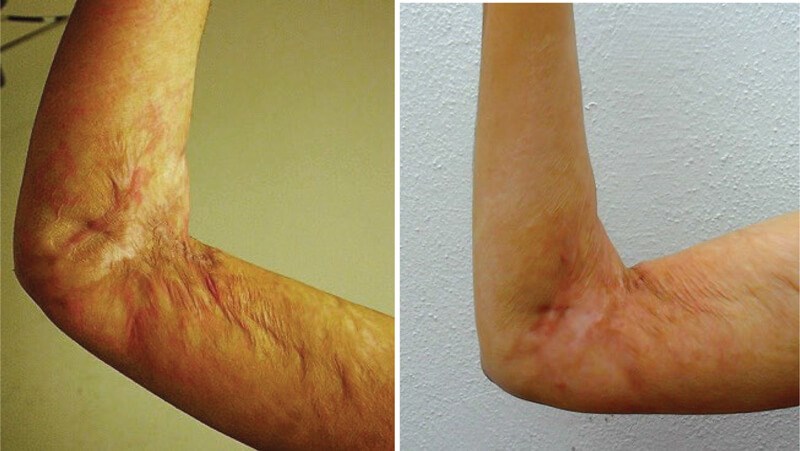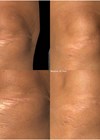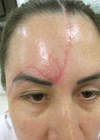Background
Scars, of any type, can be a significant source of anxiety and psychological distress, not only for the affected patient, but also for close friends and loved ones. Scars represent focalised areas of fibrous tissue that replace normal skin after trauma, and result from the biological process of wound repair.
The different scar types include keloid and hypertrohic scar, which causes contractures. Scars can also be categorised by causation for example, post-acne or post-burn scarring. Each has their own set of challenges regarding optimal therapy. Burn scars can be especially difficult to treat and can often present with a myriad of characteristics. They can appear depressed, raised, shiny, smooth or rough, can be hyper- or hypopigmented, may exhibit a play of different colours during the healing process, and can be thicker and tougher in texture when compared to normal skin.
Treatment options for the aesthetic improvement of a scar include injections of botulinum toxin, intradermal injectable products and silicone sheeting; all of which have shown efficacy in minimising the appearance of the scar, but have failed to improve motility. Energy-based devices, such as the CO₂ laser, have yielded positive clinical outcomes in the cosmesis of scar tissue, as well as improvements in associated contractures [1-3].

Figure 1: Before treatment (left) and after two weeks (two treatments).

Figure 2: Before treatment (left) and after eight weeks (three treatments).
Case report
A 37-year-old healthy Caucasian female with Fitzpatrick Skin Type III presented in our clinic with an approximately six-month old severe burn scar located over the ventral upper right arm, cubital fossa, and forearm (Figures 1 and 2). Beyond the aesthetic appearance, the burn scar area was further complicated with severe contractures over the elbow joint, impeding free movement of the arm. Following appropriate consultation, the patient opted for CO₂RE therapy (Syneron Medical), to address the burn scar.
The patient underwent a total of three treatment sessions, with each treatment performed at four to six-week intervals (four weeks at the beginning and six weeks at the end). The parameters used on the CO₂RE laser were as follows: Deep Mode, 4% coverage, 60mJ, and the square 7.5 x 7.5mm resurfacing mode shape. Continuous air-cooling was provided throughout the treatment. Following each treatment session, the target area was further cared for with epithelial regenerators, antibiotics and a sterile wound dressing was applied.
The downtime associated with each treatment was minimal, consisting of a few days of skin swelling and mild erythema. The patient reported high satisfaction with the treatment outcome. In addition to the significantly improved cosmetic appearance of the burn scar, the patient also reported a greater mobility of the arm.
Discussion
Scars are a common cosmetic concern seen in many aesthetic practices. Although numerous therapies and treatment modalities have been tried, optimal treatment still remains challenging.
The therapeutic impact of a variety of laser and light sources has been explored in the treatment of scars. However, these modalities are often limited by their side-effects, including post-inflammatory hyperpigmentation, as well as prolonged healing times, which can occur more frequently with ablative lasers. Viewed as a milestone in aesthetic medicine, fractional technology has been shown to achieve significant cosmetic outcomes, while keeping the side-effects and downtime associated with other technologies and approaches to a minimum. Bridging the divide between ablative and non-ablative lasers, fractional lasers create columns of microthermal treatment zones (MTZ) surrounded by healthy unaffected tissue, resulting in much quicker healing times.
Conclusion
The results we achieved in the burn scar were significant at just two weeks post CO₂RE treatment, demonstrating a more homogenous skin colour and tone across the scar and improvements in hypertrophic / thicker scar areas, as well as a greater mobility of the arm.
References
1. Weiss ET, Chapas A, Brightman L, et al. Successful treatment of atrophic postoperative and traumatic scarring with carbon dioxide ablative fractional resurfacing: quantitative volumetric scar improvement. Arch Dermatol 2010;146(2):133-40.
2. Levi B, Ibrahim A, Mathews K, et al. The use of CO2 fractional photothermolysis for the treatment of burn scars. J Burn Care Res 2016;37(2):106-14.
3. Ozog DM, Liu A, Chaffins ML, et al. Evaluation of clinical results, histological architecture, and collagen expression following treatment of mature burn scars with a fractional carbon dioxide laser. JAMA Dermatol 2013;149(1):50-7.
Declaration of competing interests: None declared.
COMMENTS ARE WELCOME






